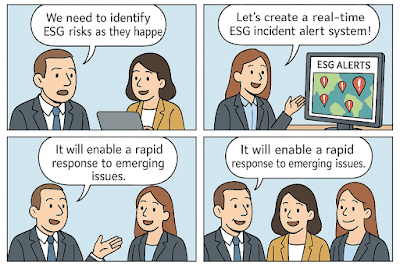How to Create Real-Time ESG Incident Alert Systems for Corporates
In a hyper-connected world, ESG (Environmental, Social, Governance) incidents can go viral within minutes—triggering consumer backlash, investor exits, or regulatory scrutiny.
Corporates need real-time alert systems that monitor global ESG developments and immediately surface risks that could impact their reputation, operations, or compliance status.
These systems combine AI, geospatial analytics, and multilingual news monitoring to provide proactive alerts and escalation workflows.
This post outlines how to architect and deploy a robust ESG alert system tailored for today’s fast-moving sustainability landscape.
Table of Contents
- Why Corporates Need Real-Time ESG Alerting
- Key Data Sources for ESG Signal Detection
- AI Models for Incident Filtering & Prioritization
- Platform Features & Notification Flows
- Vendor Tools & Case Studies
⚠️ Why Corporates Need Real-Time ESG Alerting
Delayed ESG responses lead to brand damage, investor losses, and compliance violations.
From supply chain protests to data privacy scandals, the ability to act within the first few hours can define a company’s public narrative.
Real-time systems enable corporate sustainability teams to monitor, verify, and mitigate ESG crises as they emerge.
📡 Key Data Sources for ESG Signal Detection
- Global news aggregators and financial wire services
- NGO reports and civil society press releases
- Social media APIs (X, LinkedIn, YouTube)
- Satellite feeds and environmental sensors
- Regulatory update APIs and court databases
Multilingual NLP is essential to capture non-English ESG threats.
🧠 AI Models for Incident Filtering & Prioritization
- Named Entity Recognition (NER) to match brand subsidiaries and suppliers
- Sentiment scoring to separate neutral vs. negative incidents
- Relevance ranking to filter low-risk noise
- Threat trajectory modeling (volume x spread velocity)
Use attention-based transformers for contextual understanding and reduce false positives.
📲 Platform Features & Notification Flows
- Live map of ESG alerts by region, industry, and risk category
- Custom escalation paths (email, SMS, Slack, webhook)
- Case builder for compliance/legal investigation handoff
- Weekly threat intelligence briefings by vertical
- Integration with incident management (e.g., PagerDuty, Jira)
🧰 Vendor Tools & Case Studies
- Dataminr: Real-time ESG signal detection and alerting
- Blackbird.AI: Narrative risk AI with alert distribution
- RepTrak: Corporate ESG reputation tracking
- Signal AI: ESG intelligence and media monitoring for enterprises
🔗 Related ESG Risk Monitoring Posts
Keywords: ESG alert systems, corporate risk monitoring, AI for sustainability, crisis detection, real-time ESG intelligence

